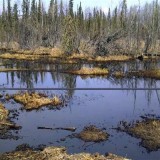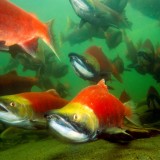Dear Adrian Dix,
The recent polls show that you and your party have a wide lead over the Liberals and Conservatives – something which gives many of us who care deeply about the environment encouragement, including thousands of us who are not usually supportive of the NDP. It is those people whom I have in mind today.
The political spectrum has altered substantially in recent years with a wide gap in centre, which your party is clearly occupying. To do this with success you must address concerns about the nineties when the NDP was in office. Apart from the fact – a big one – that the NDP had, ahem, leadership problems, in fact the NDP had a much better track record in fiscal matters than painted by the “right”, especially when one considers the sudden trauma of the “Asian ‘flu”, which all but ground our forest sector to a halt.
The Campbell/Clark Government has, with some success, painted the NDP as a government that bankrupted the province.
I believe that you should deal with those issues – though not at length, because voters want to know what you will do, not what you have done. The fact is, however, that the Liberals will present themselves as steady stewards of the public purse, which they clearly are not, and in my view you must be able to match allegations with facts.
Before I get to the environment, one other issue. When we sit around the fire relaxing with a toddy, we often muse that it would be wonderful if the federal and BC governments could just get along. The fact is that we are a federated state which sets out – not always with clarity – the powers, rights and obligations of each government. The system is built on tension, not ass-kicking, and the Premier and her party ought to know this.
Premier Clark is presently dealing with the Kitsilano Coast Guard issue with kid gloves. That may be a good policy in issues like this but in the larger sense, the people of BC, I believe, want the provincial government to stand up boldly to the Ottawa bully, especially in these days where the Harper government wishes to devastate BC’s environment.
This segues neatly into the environment issue. This issue does not lend itself to compromise. One of the “weasel” words from the developer is “mitigation”. You either protect the environment or you don’t, and three obvious issues come to mind: fish farms, private power and the pipeline/tanker debate.
On the first, you simply must force them to go on land. I believe it was a mistake to turn that power over to the Feds but that’s been done and we must deal with what we have. I suggest a protocol which requires farms to move on shore within a reasonable time or their licenses will not be renewed. The fish farmers have all denied they do to harm the environment for over a decade and they must be brought to heel. You cannot simply pawn the issue off to Fisheries and Oceans Canada – the people expect you to act.
Your position on private power (IPPs) is more than a bit hazy. You seem to be opposed to them but will, after you make the contracts public, still honour the contracts. I realize this is a tricky issue because if you go further, you will be painted as anti-business. Can you not declare that any licenses granted but not acted upon will be taken away? On other proposals, and I especially refer to the Klinaklini, surely you must say to them, “Proceed at your peril”.
And, of course, you must revive the British Columbia Utilities Commission – with teeth, as in days of yore.
This leads to BC Hydro which, if in the private sector, would be in bankruptcy protection. Much of that unhappy situation results from the IPPs from whom BC Hydro was forced to buy electricity at hugely inflated prices. Hydro has some $40 BILLION dollars in future payments for power it does not need. How can an NDP government deal with this without taking action on these contracts? Isn’t this analogous to the mayor elected on a reform ticket still honouring sweetheart deals between the former mayor and his brother-in-law? These IPP contracts are scandalous payments to the government and its political pals and cannot be protected by “sanctity of contract”
Your position on pipelines and tanker traffic is, in my view, pretty solid but must be restated at regular times. I understand that you have postponed your decision on the Kinder-Morgan line until you see what their new proposal is. That probably made sense in the Chilliwack by-election but otherwise makes no sense at all. It is a time bomb now – how can that situation be improved by increasing the line’s capacity?
The 2013 election will largely be fought on environmental issues – for the first time in my long life.
You must walk the tightrope of support of our environment and the rightwing allegations that you are anti-business. You must expect that, well before the election, the federal government, with a sweetly smiling Premier Clark, will announce big contributions to the province so that we, too, can get rich out of the Tar Sands and be prepared for that. The answer is like the joke where a man asks a woman to go to bed with him for $50,000. She muses about her obligations to her kids, etc. and blushingly agrees. The man then asks if she will go to bed with him for $50 to which the indignant woman exclaims, “What do you take me for, a common prostitute?” to which the man replies, “We’ve already established that, madam; now we’re dickering over the price.”
The lesson is our province is not for sale at any price.
Sincerely,
Rafe Mair





